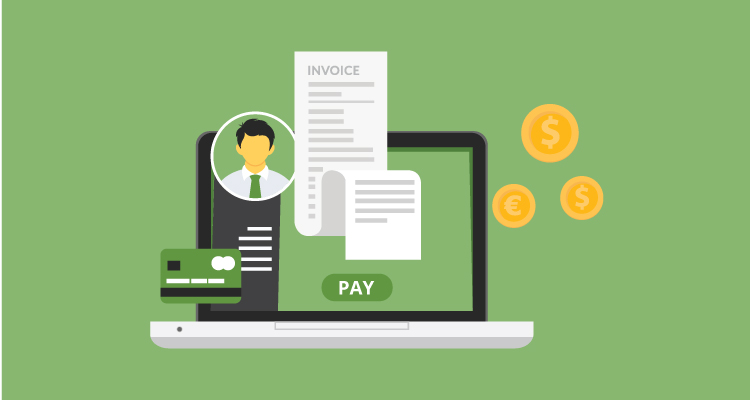Ask any freelancer why they’ve chosen this path. You’re bound to get responses like: you get to do what you love, and you can set your own schedule. Or a freelancer may tell you that they can work wherever they want. Sometimes it feels like there are many negatives to freelancing, such as finding work, keeping work, getting paid on-time, and paying taxes. In other words, there are a lot of responsibilities that need to be taken into account if you want to thrive as a freelancer. The good news is that getting paid on-time is one less thing you have to worry about. Implementing these seven effective invoicing strategies for freelancers.
Table of Contents
Toggle1. Set clear payment terms.
Your new clients should read your freelancer payment terms before the start of any work or agreements that are signed. Your terms will define your payment processes and what you expect from your clients.
Terms can include everything from payment timeframes, payment methods, and late payment fines. These terms can be published on your website and in documents, such as project proposals and deposit invoices that you send to your clients.
To get paid faster, keep your terms short and straightforward. For example, clearly state that you expect payments to be made 30 days after the invoice date has been sent.
2. Run a background check.
Before beginning work for new clients, perform an essential client screening. This process may sound a bit overboard, but it will protect you from potentially working with a deadbeat client.
Running a background check may take up some of your time, but it will prevent a lot of headaches when it’s time to bill your client.
Do a little investigative work by checking out the clients’ website and social channels to verify if they’re legit. Ask your fellow freelancers if they’ve had any experiences with the client. Use your communication skills and interpersonal skills, along with your gut, when discussing the project.
I always chat with a new client on the phone before agreeing to a project. It gives me a better idea of who they are and if we’re a good fit. It also allows me to ask more detailed questions on the scope of the project and their payment habits.
3. Automate and delegate.
Invoicing and accounting software is a godsend for freelancers. It keeps all of your invoices, taxes, and other relevant documents organized. Some tools even come with features like time tracking so that you can accurately invoice billable hours.
Most importantly, invoicing software also comes with powerful automation features that will save you a ton of time and money. The software lets you create recurring invoices, send upcoming payment reminders, and automatically follow-up on late payments.
Don’t rely solely on automation. It’s still your responsibility to manage your bills. You will need to call a client when the invoice is late personally. If you don’t have the time or desire to keep track of these details, you can also consider delegating this task to a freelance accountant or bookkeeper.
4. Collect payments upfront.
Always get an upfront payment before working with new clients. It can prevent you from forgetting to invoice. This practice also separates leads from clients and simplifies your invoicing schedule.
It will also protect you from getting played. It’s the norm for freelancers to require a 50 percent deposit before work begins, or at least a 25 percent upfront fee.
5. The carrot and the stick.
“Even if you’ve followed invoicing best practices, there will be times when a client simply doesn’t have the money to pay you. Some clients tend always to be late with the payments they owe you.
“Others wait to pay until the very last minute,” writes Deanna Rampton in a previous Due article. “Instead of losing your cool, have a strategy in place that will entice the client to pay your invoice on-time.”
You can use the following carrot and stick combo: “For the carrot, offer some sort of incentive to pay the invoice, such as a discount off the total amount of the invoice if paid early.”
“For the stick, e.g., late payment, implement late penalty fees if the invoice goes past the due date. It may be a small percentage or flat fee at first. If you need to raise the penalty, or the costs continue to increase each month, the client will be motivated to prevent this from happening. Generally, they will begin to pay the bill on time.”
“If those tactics don’t work, consider offering a payment plan,” Ms. Rampton suggests. “You may receive a smaller payment each month, but it’s better than nothing.”
6. Accept multiple types of payments.
Thanks to the power of the Internet, you can easily collect payments online. It’s convenient for both parties and makes getting paid almost instantaneous. When accepting payments online, just be aware that processing fees typically apply.
Today, most people have a PayPal account, but you can also accept credit card payments in person, online, or even over the phone with tools like Flint and Square.
Other payment options would be ACH with Dwolla or cryptocurrencies like Bitcoin — both are immediate and cheaper than credit cards.
If you use software like Due, your clients can pay directly from the invoice. Payments straight from the invoice make accepting payments simple and secure for both you and your clients.
7. Be kind, but stand your ground.
It always pays for freelancers to be professional. Rudeness makes the client feel bad about you — not just the needed payment for the invoice. More importantly, merely adding “please pay your invoice within” or “thank you for your business” can increase the percentage of invoices that are paid.
Some studies have shown invoices more likely to be paid with extra courtesy extended since it strengthens the relationship you have with the client.
At the same time, there will be times when you have to be more aggressive. Sometimes a client avoids paying a bill even with follow-ups. In these cases, you start by using emails and phone calls.
Sometimes these are ineffective, and you may want to hire some muscle — like another freelancer — to serve as a personal assistant or informal collection agent. The client may respond since they don’t want to explain themselves to a stranger.
Other tactics would be having your attorney send them a letter or taking them to small claims court if the bills are high enough.














